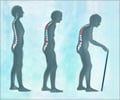
The prevalence of osteoporosis in postmenopausal women in urban Tianjin, China and its related factors
Go to source). In recent years, osteoporosis has become a global public health concern because of its negative effects on quality of life and its proven link with increased mortality and a significant financial burden to society. As a bone disease that develops when bone mineral density and bone mass decrease, it leads to weak and brittle bones that are more vulnerable to fracture.
‘Osteoporosis, the bone disease is a serious health threat and has an effect on mortality.’
Tweet it Now
According to the International Osteoporosis Foundation, one in three women aged older than 50 years will experience fragility fractures (2✔ ✔Trusted SourceAn overview and management of osteoporosis
Go to source), including the most severe, hip fracture. Approximately 24% of these women die within one year of hip fracture, and 40% of the survivors will lose the ability to walk independently.
Osteoporosis Among Women
Women are at greater risk of developing osteoporosis than men, especially as they age, because the hormone changes that happen during menopause directly affect bone density. Despite its growing prevalence because of an aging population and its adverse health effects, a new study out of China found that most women are only familiar with the disease’s name and lack an understanding of the dangers it poses, as well as the importance of early diagnosis and treatment.In this study of 240 postmenopausal women, the overall prevalence of osteoporosis reached 52.08%. Most disturbing was the fact that 65% had not undergone any form of bone mineral density testing, despite the fact that 52.92% of participants had experienced fractures, most of which were attributable to osteoporosis. Most of these women did not undergo treatment because they were unaware that they had the disease. Among the participants, 41.25% stated that they would only accept osteoporosis-related treatment after experiencing adverse events, such as pain.
Among other misconceptions, most of the study participants believed that osteoporosis was less dangerous than heart disease, and 37.92% of the study participants expressed the view that hypertension and diabetes were significantly more dangerous than osteoporosis. The researchers in this latest study theorized that misconceptions like these, as well as a general lack of awareness, are primary reasons why so few women are pursuing osteoporosis testing and treatment. Without effective and early therapies, the number of osteoporotic fractures and the associated economic costs are expected to double by 2035.
“From a public health perspective, education is needed to improve awareness of the disease. Clinicians can help postmenopausal women optimize their skeletal health by assessing risk factors for fracture, reducing modifiable risk factors through dietary and lifestyle changes, and using pharmacologic therapy in women at significant risk of osteoporosis or fracture,” says Dr. Stephanie Faubion, NAMS medical director.
References:
- The prevalence of osteoporosis in postmenopausal women in urban Tianjin, China and its related factors - (https://pubmed.ncbi.nlm.nih.gov/37279508/)
- An overview and management of osteoporosis - (https://www.ncbi.nlm.nih.gov/pmc/articles/PMC5335887/)















